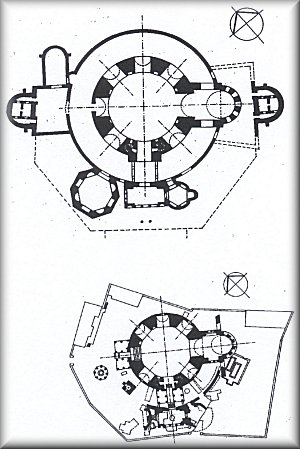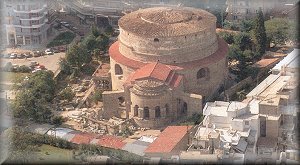
The Rotunda
 |
The Rotunda as it was in the early Christian era after its conversion into a Christian Church...
|
|
...and
as it is today. |
The enormous circular building called the Rotunda was built around 300 AD by Emperor Galerius, as a temple either of Cabeiros or Zeus. The magnificent monument is impressive for its dimensions; the strong walls are 6.30 metres thick, the interiour diameter of the building is 24.50 metres and its height to the top of the dome is 29.80 metres. The lower section of the interior wall consists of eight rectangular vaulted recesses, decorated with mosaics. The interior of the monument is striking and the huge spaces beneath the vast dome - which in the light pouring in from the many windows appears to be suspended in space - inspires a sense of awe in the visitor.
In the time of the Byzantine Emperor Theodosius (379 - 395), the Rotunda was converted into a Christian church, and after 1590 it became a mosque. It takes the name of St George (Agios Georgios) by which it is often called from the nearby chapel of that name, while Rotunda was the name given in recent centuries by foreign visitors as, a result of the circular shape of the monument. In the period from 1912 to 1920, the building was used once more as a church, and after 1920 - until the big earthquake of 1978 (6.5 Richter scale) it housed collections of early Christian and Byzantine sculptures. It was seriously damaged by the earthquake, but it has now been repaired and since 1995 the Rotunda has functioned as a timeless memorial for religious and artistic events.
The process of converting the Rotunda into a Christian church involved the addition of an altar apse to th east and of a narthex to the south, while the famous mosaics were created in the interior. In the ninth century, the altar apse was decorated with a wallpainting of the Ascension. This work was an excellent example of the art of Thessaloniki in the period after the Iconoclastic Controversy.
Unfortunately, however, it has survived in poor condition because in the sixteenth century, when the Rotunda became a mosque, attempts were made by the Turks to hammer it off altogether.
